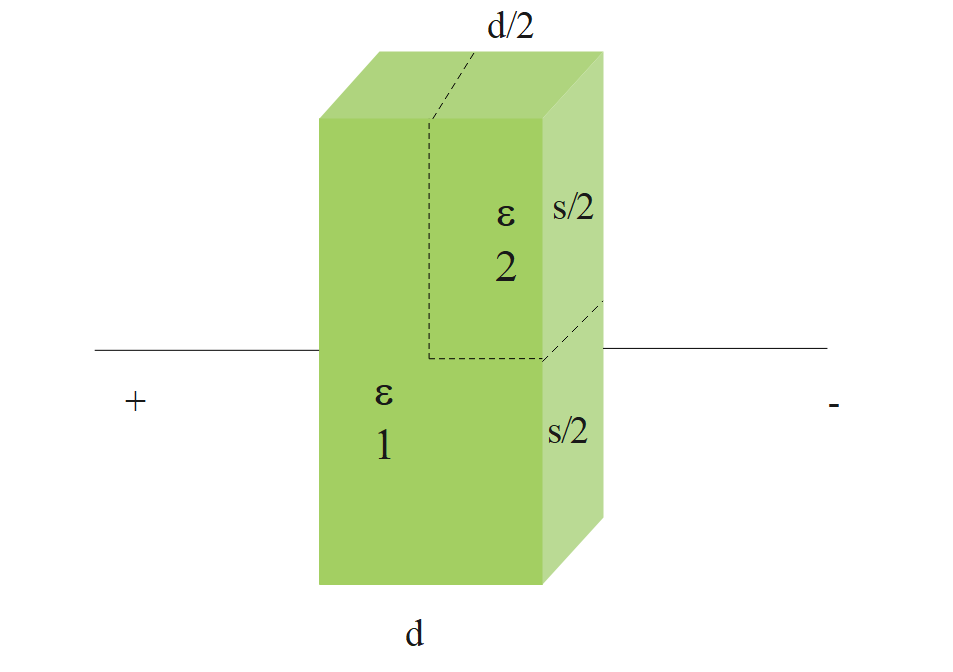
A parallel plate capacitor having plates of area S and plate separation d, has capacitance $C_1$ in air. When two dielectrics of different relative permittivity $({{\varepsilon }_{1}}=2,{{\varepsilon }_{2}}=4)$ are introduced between the two plates as shown in the figure, the capacitance become $C_2$. The ratio $\dfrac{{{C}_{2}}}{{{C}_{1}}}$ is.


Answer
557.4k+ views
Hint: Let us first divide the capacitor into three parts. The first part is the top part beside the new dielectric. The second is the part of the capacitor that is now introduced with new permittivity. The third part is the bottom part of the whole capacitor. We need to find the equivalent capacitor of the new capacitor formed by introducing new permittivity and divide it with the old net capacitance.
Formula used:
$C=\dfrac{\varepsilon A}{d}$
Complete step by step answer:
let us first wire down the given quantities and values,
Area of the capacitor is S
Plate separation is d.
Let us first find the capacitance of the capacitor when it is in the air,
$\begin{align}
& {{C}_{1}}=\dfrac{\varepsilon A}{d} \\
& {{C}_{1}}=\dfrac{\varepsilon S}{d} \\
\end{align}$
Now, let us find the capacitance of the capacitor when dielectrics are inserted,
Let u divide the three parts into ${{C}_{2}},{{C}_{3}},{{C}_{4}}$
${{C}_{2}}$will be the capacitance of the part where dielectric is inserted,
$\begin{align}
& {{C}_{2}}=\dfrac{{{\varepsilon }_{2}}S}{d} \\
& \Rightarrow {{C}_{2}}=\dfrac{4{{\varepsilon }_{0}}S}{d} \\
\end{align}$
${{C}_{3}}$will be the capacitance of the part adjacent to ${{C}_{2}}$
$\begin{align}
& {{C}_{3}}=\dfrac{{{\varepsilon }_{1}}S}{d} \\
& \Rightarrow {{C}_{3}}=\dfrac{2{{\varepsilon }_{0}}S}{d} \\
\end{align}$
The third part is the capacitance of the rest capacitor,
${{C}_{4}}=\dfrac{{{\varepsilon }_{0}}S}{d}$
Now, the effective resistance of the two parts that are adjacent will be,
As they are in series,
$\begin{align}
& {{C}_{eff}}=\dfrac{{{C}_{1}}\times {{C}_{2}}}{{{C}_{1}}+{{C}_{2}}} \\
& \Rightarrow {{C}_{eff}}=\dfrac{\dfrac{4{{\varepsilon }_{0}}S}{d}\times \dfrac{2{{\varepsilon }_{0}}S}{d}}{\dfrac{6{{\varepsilon }_{0}}S}{d}} \\
& \Rightarrow {{C}_{eff}}=\dfrac{4{{\varepsilon }_{0}}S}{3d} \\
\end{align}$
Now, the remaining part of the capacitor and this effective capacitance are in parallel, the net capacitance now will be,
$\begin{align}
& {{C}_{eq}}=\dfrac{4{{\varepsilon }_{0}}S}{d}+\dfrac{{{\varepsilon }_{0}}S}{d} \\
& \Rightarrow {{C}_{eq}}=\dfrac{7{{\varepsilon }_{0}}S}{d} \\
\end{align}$
The ratio between the effective capacitance that we obtained now and the initial capacitance will be,
$\begin{align}
& ratio=\dfrac{\dfrac{7{{\varepsilon }_{0}}S}{d}}{\dfrac{{{\varepsilon }_{0}}S}{d}} \\
& \therefore ratio=\dfrac{7}{3} \\
\end{align}$
Note: The effective combination of the capacitors and resistances are a lot different. They are opposite to each other. The equivalent resistance of two resistor formulas will be the same as the series combination of the capacitors, they are quite opposite. The same goes for the series resistance and parallel capacitors. So, we need to be sure during the calculations of series and [parallel combinations of capacitors and resistors.
Formula used:
$C=\dfrac{\varepsilon A}{d}$
Complete step by step answer:
let us first wire down the given quantities and values,
Area of the capacitor is S
Plate separation is d.
Let us first find the capacitance of the capacitor when it is in the air,
$\begin{align}
& {{C}_{1}}=\dfrac{\varepsilon A}{d} \\
& {{C}_{1}}=\dfrac{\varepsilon S}{d} \\
\end{align}$
Now, let us find the capacitance of the capacitor when dielectrics are inserted,
Let u divide the three parts into ${{C}_{2}},{{C}_{3}},{{C}_{4}}$
${{C}_{2}}$will be the capacitance of the part where dielectric is inserted,
$\begin{align}
& {{C}_{2}}=\dfrac{{{\varepsilon }_{2}}S}{d} \\
& \Rightarrow {{C}_{2}}=\dfrac{4{{\varepsilon }_{0}}S}{d} \\
\end{align}$
${{C}_{3}}$will be the capacitance of the part adjacent to ${{C}_{2}}$
$\begin{align}
& {{C}_{3}}=\dfrac{{{\varepsilon }_{1}}S}{d} \\
& \Rightarrow {{C}_{3}}=\dfrac{2{{\varepsilon }_{0}}S}{d} \\
\end{align}$
The third part is the capacitance of the rest capacitor,
${{C}_{4}}=\dfrac{{{\varepsilon }_{0}}S}{d}$
Now, the effective resistance of the two parts that are adjacent will be,
As they are in series,
$\begin{align}
& {{C}_{eff}}=\dfrac{{{C}_{1}}\times {{C}_{2}}}{{{C}_{1}}+{{C}_{2}}} \\
& \Rightarrow {{C}_{eff}}=\dfrac{\dfrac{4{{\varepsilon }_{0}}S}{d}\times \dfrac{2{{\varepsilon }_{0}}S}{d}}{\dfrac{6{{\varepsilon }_{0}}S}{d}} \\
& \Rightarrow {{C}_{eff}}=\dfrac{4{{\varepsilon }_{0}}S}{3d} \\
\end{align}$
Now, the remaining part of the capacitor and this effective capacitance are in parallel, the net capacitance now will be,
$\begin{align}
& {{C}_{eq}}=\dfrac{4{{\varepsilon }_{0}}S}{d}+\dfrac{{{\varepsilon }_{0}}S}{d} \\
& \Rightarrow {{C}_{eq}}=\dfrac{7{{\varepsilon }_{0}}S}{d} \\
\end{align}$
The ratio between the effective capacitance that we obtained now and the initial capacitance will be,
$\begin{align}
& ratio=\dfrac{\dfrac{7{{\varepsilon }_{0}}S}{d}}{\dfrac{{{\varepsilon }_{0}}S}{d}} \\
& \therefore ratio=\dfrac{7}{3} \\
\end{align}$
Note: The effective combination of the capacitors and resistances are a lot different. They are opposite to each other. The equivalent resistance of two resistor formulas will be the same as the series combination of the capacitors, they are quite opposite. The same goes for the series resistance and parallel capacitors. So, we need to be sure during the calculations of series and [parallel combinations of capacitors and resistors.
Recently Updated Pages
A man running at a speed 5 ms is viewed in the side class 12 physics CBSE

The number of solutions in x in 02pi for which sqrt class 12 maths CBSE

State and explain Hardy Weinbergs Principle class 12 biology CBSE

Write any two methods of preparation of phenol Give class 12 chemistry CBSE

Which of the following statements is wrong a Amnion class 12 biology CBSE

Differentiate between action potential and resting class 12 biology CBSE

Trending doubts
What are the major means of transport Explain each class 12 social science CBSE

Which are the Top 10 Largest Countries of the World?

Draw a labelled sketch of the human eye class 12 physics CBSE

How much time does it take to bleed after eating p class 12 biology CBSE

Explain sex determination in humans with line diag class 12 biology CBSE

Explain sex determination in humans with the help of class 12 biology CBSE




